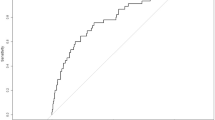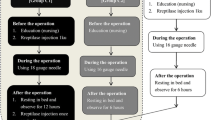Abstract
Intraoperative hemorrhage is an important factor affecting intraoperative safety and postoperative patient recovery in percutaneous nephrolithotomy (PCNL). This study aimed to identify the factors that influence intraoperative hemorrhage during PCNL and develop a predictive nomogram model based on these factors.A total of 118 patients who underwent PCNL at the Department of Urology, The Affiliated Huai’an No.1 People’s Hospital of Nanjing Medical University from January 2021 to September 2023 was included in this study. The patients were divided into a hemorrhage group (58 cases) and a control group (60 cases) based on the decrease in hemoglobin levels after surgery. The clinical data of all patients were collected, and both univariate analysis and multivariate logistic regression analysis were conducted to identify the independent risk factors for intraoperative hemorrhage during PCNL. The independent risk factors were used to construct a nomogram model using R software. Additionally, receiver operating characteristic (ROC) curves, calibration curves and decision curve analysis (DCA) were utilized to evaluate the model.Multivariate logistic regression analysis revealed that diabetes, long operation time and low psoas muscle mass index (PMI) were independent risk factors for intraoperative hemorrhage during PCNL (P < 0.05). A nomogram model was developed incorporating these factors, and the areas under the ROC curve (AUCs) in the training set and validation set were 0.740 (95% CI: 0.637–0.843) and 0.742 (95% CI: 0.554–0.931), respectively. The calibration curve and Hosmer-Lemeshow test (P = 0.719) of the model proved that the model was well fitted and calibrated. The results of the DCA showed that the model had high value for clinical application.Diabetes, long operation time and low PMI were found to be independent risk factors for intraoperative hemorrhage during PCNL. The nomogram model based on these factors can be used to predict the risk of intraoperative hemorrhage, which is beneficial for perioperative intervention in high-risk groups to improve the safety of surgery and reduce the incidence of postoperative complications.





Similar content being viewed by others
Data availability
Data is available on request by contacting the authors.
References
Tan S, Yuan D, Su H, Chen W, Zhu S, Yan B, Sun F, Jiang K, Zhu J (2024) Prevalence of urolithiasis in China: a systematic review and meta-analysis. BJU Int 133(1):34–43. https://doi.org/10.1111/bju.16179
Fernström I, Johansson B (1976) Percutaneous pyelolithotomy. A new extraction technique. Scand J Urol Nephrol 10(3):257–259. https://doi.org/10.1080/21681805.1976.11882084
Geraghty RM, Davis NF, Tzelves L, Lombardo R, Yuan C, Thomas K, Petrik A, Neisius A, Türk C, Gambaro G, Skolarikos A, Somani BK (2023) Best practice in Interventional Management of Urolithiasis: an update from the European Association of Urology Guidelines Panel for Urolithiasis 2022. Eur Urol Focus 9(1):199–208. https://doi.org/10.1016/j.euf.2022.06.014
Ullah S, Ali S, Karimi S, Farooque U, Hussain M, Qureshi F, Shah SI, Afzal A, Tauseef A, Khan MU (2020) Frequency of blood transfusion in Percutaneous Nephrolithotomy. Cureus 12(10):e11086. https://doi.org/10.7759/cureus.11086
Lee JK, Kim BS, Park YK (2013) Predictive factors for bleeding during percutaneous nephrolithotomy. Korean J Urol 54(7):448–453. https://doi.org/10.4111/kju.2013.54.7.448
Eksi M, Ozlu DN, Kargi T, Yavuzsan AH, Haciislamoglu A, Karadag S, Sahin S, Tasci AI (2022) Pre-operative parameters Predicting Hemoglobin decline related to Percutaneous Nephrolithotomy. Sisli Etfal Hastan Tip Bul 56(1):70–76. https://doi.org/10.14744/SEMB.2021.21284
Bahat G, Turkmen BO, Aliyev S, Catikkas NM, Bakir B, Karan MA (2021) Cut-off values of skeletal muscle index and psoas muscle index at L3 vertebra level by computerized tomography to assess low muscle mass. Clin Nutr 40(6):4360–4365. https://doi.org/10.1016/j.clnu.2021.01.010
Jung JW, Lee BK, Park YH, Lee S, Jeong SJ, Lee SE, Jeong CW (2014) Modified Seoul National University Renal Stone Complexity score for retrograde intrarenal surgery. Urolithiasis 42(4):335–340. https://doi.org/10.1007/s00240-014-0650-7
Okhunov Z, Friedlander JI, George AK, Duty BD, Moreira DM, Srinivasan AK, Hillelsohn J, Smith AD, Okeke Z (2013) S.T.O.N.E. nephrolithometry: novel surgical classification system for kidney calculi. Urology 81(6):1154–1159. https://doi.org/10.1016/j.urology.2012.10.083
Wollin DA, Preminger GM (2018) Percutaneous nephrolithotomy: complications and how to deal with them. Urolithiasis 46(1):87–97. https://doi.org/10.1007/s00240-017-1022-x
Akman T, Binbay M, Sari E, Yuruk E, Tepeler A, Akcay M, Muslumanoglu AY, Tefekli A (2011) Factors affecting bleeding during percutaneous nephrolithotomy: single surgeon experience. J Endourol 25(2):327–333. https://doi.org/10.1089/end.2010.0302
Poudyal S (2022) Current insights on haemorrhagic complications in percutaneous nephrolithotomy. Asian J Urol 9(1):81–93. https://doi.org/10.1016/j.ajur.2021.05.007
Tefekli A, Kurtoglu H, Tepeler K, Karadag MA, Kandirali E, Sari E, Baykal M, Muslumanoglu AY (2008) Does the metabolic syndrome or its components affect the outcome of percutaneous nephrolithotomy? J Endourol 22(1):35–40. https://doi.org/10.1089/end.2007.0034
Mithani MH, Khan SA, Khalid SE, Majeed I, Awan AS, Mithani S (2018) Predictive factors for intraoperative blood loss during Percutaneous Nephrolithotomy. J Coll Physicians Surg Pak 28(8):623–627. https://doi.org/10.29271/jcpsp.2018.08.623
Zheng Z, Xu J, Li Z, Mao L, Zhang W, Ye Z, Zhong W (2023) Development and internal validation of a prediction model to evaluate the risk of severe hemorrhage following mini-percutaneous nephrolithotomy. World J Urol 41(3):843–848. https://doi.org/10.1007/s00345-023-04291-5
Oner S, Okumus MM, Demirbas M, Onen E, Aydos MM, Ustun MH, Kilic M, Avci S (2015) Factors influencing complications of Percutaneous Nephrolithotomy: a single-center study. Urol J 12(5):2317–2323
Shoaib M, Bangash M, Salam B, Ather MH (2020) The correlation between STONE nephrolithometry score and Hemoglobin Drop in patients undergoing Percutaneous Nephrolithotomy. Cureus 12(11):e11430. https://doi.org/10.7759/cureus.11430
Meng X, Bao J, Mi Q, Fang S (2019) The Analysis of Risk Factors for Hemorrhage Associated with minimally invasive percutaneous nephrolithotomy. Biomed Res Int 2019(8619460). https://doi.org/10.1155/2019/8619460
Turna B, Nazli O, Demiryoguran S, Mammadov R, Cal C (2007) Percutaneous nephrolithotomy: variables that influence hemorrhage. Urology 69(4):603–607. https://doi.org/10.1016/j.urology.2006.12.021
Amri M, Naouar S, Ben Khalifa B, Hmidi N, Braiek S, ElKamel R (2019) Predictive factors of bleeding and fever after percutaneous nephrolithotomy. Tunis Med 97(5):667–674
Hamaguchi Y, Kaido T, Okumura S, Kobayashi A, Hammad A, Tamai Y, Inagaki N, Uemoto S (2016) Proposal for new diagnostic criteria for low skeletal muscle mass based on computed tomography imaging in Asian adults. Nutrition 32(11–12):1200–1205. https://doi.org/10.1016/j.nut.2016.04.003
Xue D, Li N, Li L, Huang Y, Men K, Meng Q, Zhang S (2022) Sarcopenia is an independent risk factor for depression in patients with advanced lung cancer. Support Care Cancer 30(11):9659–9665. https://doi.org/10.1007/s00520-022-07384-w
Li Q, An T, Wu J, Lu W, Wang Y, Li J, Yang L, Chen Y, Lin, Yang Z (2023) The impact of Sarcopenia on the outcome of patients with left-sided colon and rectal cancer after curative surgery. BMC Cancer 23(1):640. https://doi.org/10.1186/s12885-023-11073-0
Umezawa S, Kobayashi S, Otsubo T (2022) Low preoperative psoas muscle mass index is a risk factor for distal cholangiocarcinoma recurrence after pancreatoduodenectomy: a retrospective analysis. World J Surg Oncol 20(1):176. https://doi.org/10.1186/s12957-022-02627-w
Zhang Y, Dilixiati Y, Jiang W, Cao X, Chen Y, Guo H (2022) Correlation of Psoas Muscle Index with Fragility Vertebral Fracture: A Retrospective Cross-Sectional Study of Middle-Aged and Elderly Women. Int J Endocrinol 2022, 4149468. https://doi.org/10.1155/2022/4149468
Iwasaki Y, Shiotsuka J, Kawarai Lefor A, Sanui M (2021) The Psoas muscle index is Associated with Prognosis in Elderly patients Undergoing Cardiovascular surgery. Anesth Pain Med 11(5):e118608. https://doi.org/10.5812/aapm.118608
Lee SJ, Yang YJ, Lee DW, Song SY, Lew DH, Yang EJ (2023) Influence of Sarcopenia on postoperative complications in patients undergoing autologous microsurgical breast reconstruction: an inverse probability of treatment weighting analysis. Front Oncol 13:1211593. https://doi.org/10.3389/fonc.2023.1211593
Kim HY, Lee KW, Lee DS (2020) Critical causes in severe bleeding requiring angioembolization after percutaneous nephrolithotomy. BMC Urol 20(1):22. https://doi.org/10.1186/s12894-020-00594-6
Funding
Not applicable.
Author information
Authors and Affiliations
Contributions
Research design: JHX, LJ, YYW; Data collection: JHX, SG, XZL; Data analysis: JHX, LJ; Manuscript writing: JHX; All authors read and approved the final manuscript.
Corresponding author
Ethics declarations
Ethical approval
This study was approved by the Ethics Committee of the Affiliated Huai’an No.1 People’s Hospital of Nanjing Medical University (Ethical approval No.: KY-2024-070-01). As a retrospective study, the patients were exempted from written informed consent.
Conflict of interest
All authors declare no conflict of interest.
Additional information
Publisher’s Note
Springer Nature remains neutral with regard to jurisdictional claims in published maps and institutional affiliations.
Rights and permissions
Springer Nature or its licensor (e.g. a society or other partner) holds exclusive rights to this article under a publishing agreement with the author(s) or other rightsholder(s); author self-archiving of the accepted manuscript version of this article is solely governed by the terms of such publishing agreement and applicable law.
About this article
Cite this article
Xu, J., Ji, L., Gu, S. et al. Analysis of factors affecting intraoperative hemorrhage during percutaneous nephrolithotomy and establishment of nomogram model. Urolithiasis 52, 71 (2024). https://doi.org/10.1007/s00240-024-01571-6
Received:
Accepted:
Published:
DOI: https://doi.org/10.1007/s00240-024-01571-6




